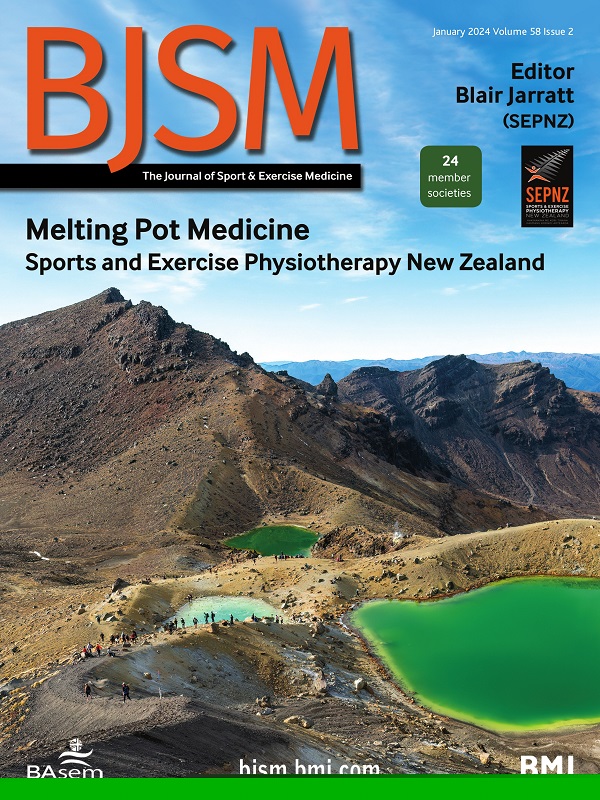Prevention strategies and modifiable risk factors for concussion: a systematic review and meta-analysis for the Female, woman and girl Athlete Injury pRevention (FAIR) consensus
IF 16.2
1区 医学
Q1 SPORT SCIENCES
引用次数: 0
Abstract
Objective To examine prevention strategies and potential modifiable risk factors (MRFs) for sport-related concussion (SRC) and head impact/head acceleration event (HAE) outcomes in female, woman and/or girl athletes. Design Systematic review with meta-analyses and Grading of Recommendations, Assessment, Development and Evaluation. Data sources Medline, CINAHL, PsycINfo, SportDiscus, ERIC, CENTRAL and CDSR. Eligibility Primary data studies with comparison group(s) assessing the association of prevention interventions and/or MRFs for SRC or HAE with ≥1 female/woman/girl in each study group. Results Of the 108 included studies, 67 evaluated a SRC prevention strategy (equipment n=25, policy/rule n=21, training n=10, management n=11) and 41 evaluated potential MRFs (34 distinct MRFs across nine categories). In total, 40/108 (37%) studies (prevention 19/67; MRF 21/41) included female/woman/girl-specific estimates. Three meta-analyses were conducted: two SRC prevention strategies (headgear, eyewear) and one MRF (artificial turf vs grass) based on availability of female/woman/girl-only estimates and similar outcomes and exposure. Headgear was associated with 30% lower SRC rates in adolescent female/girl lacrosse and soccer (IRR=0.70, 95% CI 0.50 to 0.99; very-low certainty). Eyewear use was not protective for SRC (IRR=1.08, 95% CI 0.69 to 1.68; very-low certainty). SRC rates did not differ by artificial turf versus grass (IRR=0.95, 95% CI 0.62 to 1.45; very-low certainty). Conclusion We found limited evidence for prevention strategies and MRFs in female/woman/girl athletes except for very-low certainty evidence supporting headgear use in adolescent lacrosse and soccer. Future studies should consider the design, implementation and evaluation of SRC prevention strategies that target MRFs to guide safe practice recommendations specifically for female/woman/girl athletes. Data are available upon reasonable request. Deidentified data can be made available upon reasonable request to the corresponding author. Please email the corresponding author with a written proposal outlining the specific research aims and analysis plan and why these specific data are needed. A formal data-sharing agreement between institutions will be required.脑震荡的预防策略和可改变的危险因素:对女性、女性和女孩运动员损伤预防(FAIR)共识的系统回顾和荟萃分析
目的探讨女性、女性和/或女童运动员运动相关脑震荡(SRC)和头部撞击/头部加速事件(HAE)结局的预防策略和潜在可改变危险因素(mrf)。设计系统的评价与荟萃分析和分级的建议,评估,发展和评价。数据来源:Medline, CINAHL, PsycINfo, SportDiscus, ERIC, CENTRAL和CDSR。主要资料研究与对照组评估预防干预和/或MRFs与每个研究组中≥1名女性/女性/女孩的相关性。在纳入的108项研究中,67项评估了SRC预防策略(设备n=25,政策/规则n=21,培训n=10,管理n=11), 41项评估了潜在的mrf(9类34种不同的mrf)。总共有40/108(37%)项研究(预防19/67;MRF 21/41)纳入了针对女性/女性/女孩的估计。进行了三项meta分析:两种SRC预防策略(头饰、眼镜)和一种MRF(人造草坪vs草皮),基于女性/女性/女孩估计的可用性以及类似的结果和暴露。在青少年女子曲棍球和足球比赛中,头饰与SRC发生率降低30%相关(IRR=0.70, 95% CI 0.50至0.99;非常低的确定性)。眼镜使用对SRC没有保护作用(IRR=1.08, 95% CI 0.69 ~ 1.68;非常低的确定性)。人造草坪和天然草坪的SRC率没有差异(IRR=0.95, 95% CI 0.62至1.45;非常低的确定性)。结论:除了支持青少年长曲棍球和足球运动员戴头盔的证据非常低外,我们在女/女/女孩运动员中发现的预防策略和磁共振成像证据有限。未来的研究应考虑针对mrf的SRC预防策略的设计、实施和评估,以指导专门针对女/女/女童运动员的安全练习建议。如有合理要求,可提供资料。在向通讯作者提出合理要求时,可以提供未识别的数据。请给通讯作者发一份书面提案,概述具体的研究目的和分析计划,以及为什么需要这些具体的数据。各机构之间需要签署正式的数据共享协议。
本文章由计算机程序翻译,如有差异,请以英文原文为准。
求助全文
约1分钟内获得全文
求助全文
来源期刊
CiteScore
27.10
自引率
4.90%
发文量
217
审稿时长
3-8 weeks
期刊介绍:
The British Journal of Sports Medicine (BJSM) is a dynamic platform that presents groundbreaking research, thought-provoking reviews, and meaningful discussions on sport and exercise medicine. Our focus encompasses various clinically-relevant aspects such as physiotherapy, physical therapy, and rehabilitation. With an aim to foster innovation, education, and knowledge translation, we strive to bridge the gap between research and practical implementation in the field. Our multi-media approach, including web, print, video, and audio resources, along with our active presence on social media, connects a global community of healthcare professionals dedicated to treating active individuals.

 求助内容:
求助内容: 应助结果提醒方式:
应助结果提醒方式:


